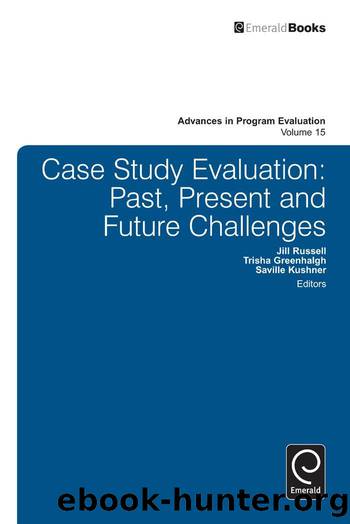Case Study Evaluation by Greenhalgh Trish;Russell Jill;Kushner Saville;Russell Jill;

Author:Greenhalgh, Trish;Russell, Jill;Kushner, Saville;Russell, Jill;
Language: eng
Format: epub
Publisher: Emerald Publishing Limited
Published: 2014-08-15T00:00:00+00:00
LIMITATIONS
The case of the collective experience of dementia and within this the impact of a mobile programme of support and education in a predominately rural area grew from the investigation of the programme experience of âindividual casesâ of carers and PWD. As the interview extracts show, the broader case is mapped out through the in-depth interviews with carers and then explored through interviews with family members, staff and other service providers. The âthick descriptionâ from the perspective of carers thins out around the edges of the collective case and limited the development of a theory of change that encompasses the true complexity of the bounded programme within its broader context. For example, the stigma experienced by individual carers such as Sandra is a manifestation of the stigma of dementia in the broader social context. This stigma is linked to not only to decreased social networks for the carer and the reluctance to seek assistance and a diagnosis but also to the reluctance of medical practitioners to diagnose the condition and of family members and friends to acknowledge it. It is stigma related to the broader dread of getting dementia of people within any Australian population, affecting what family members, friends, neighbours, medical practitioners and other services providers understand and how they act.
Investigation of living conditions, relationships, service interactions through observation and more depth in the interviews with service providers and family members would have provided valuable perspectives, a thicker description of the case and the development of a more complete theory of change. Even with its limitations, the MRT evaluation case study unravels some of the social, cultural and political context within which people experience the programme. This demonstrates both programme value through identifying key components of a theory of change and evidence of causality and maps key programme processes and the programme model for application elsewhere. Broadening the thick description of the case study to include the outer boundaries of the case by incorporating in-depth interviews with programme management, service providers, medical practitioners and specialists and family members would provide true triangulation of perspectives and exploration of all facets of dementia care. This greater understanding of the bounded system would add value to understanding the contextual conditions and a more complete theory of change for application of the programme elsewhere.
Much would be gained through exploration of the relationships between MRT staff and other service providers including the importance of different personal attributes of workers and the impact of this on how they work together. More in-depth understanding of how MRT staff navigated the additional stigma of institutionalisation of loved ones to include as a key programme element an increased familiarity and smoothed transition for PWD into RAC would be of value. The âbalancing actâ of gently planning and supporting the transition to institutional care within the context of a highly stigmatised condition (dementia) and a highly stigmatised and emotionally loaded act (placement in RAC) is a critical attribute of the programme requiring more in-depth study.
Download
This site does not store any files on its server. We only index and link to content provided by other sites. Please contact the content providers to delete copyright contents if any and email us, we'll remove relevant links or contents immediately.
The Art of Coaching Workbook by Elena Aguilar(50996)
Trainspotting by Irvine Welsh(21521)
Twilight of the Idols With the Antichrist and Ecce Homo by Friedrich Nietzsche(18508)
Fangirl by Rainbow Rowell(9100)
Periodization Training for Sports by Tudor Bompa(8173)
Change Your Questions, Change Your Life by Marilee Adams(7638)
This Is How You Lose Her by Junot Diaz(6800)
Asking the Right Questions: A Guide to Critical Thinking by M. Neil Browne & Stuart M. Keeley(5651)
Grit by Angela Duckworth(5525)
Red Sparrow by Jason Matthews(5391)
Paper Towns by Green John(5092)
Room 212 by Kate Stewart(5041)
Ken Follett - World without end by Ken Follett(4647)
Housekeeping by Marilynne Robinson(4349)
The Sports Rules Book by Human Kinetics(4299)
Double Down (Diary of a Wimpy Kid Book 11) by Jeff Kinney(4208)
Papillon (English) by Henri Charrière(4199)
The Motorcycle Diaries by Ernesto Che Guevara(4018)
Exercise Technique Manual for Resistance Training by National Strength & Conditioning Association(3958)
